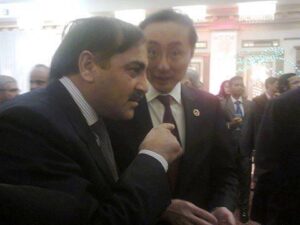By Ahsan Ansari
On February 23, 2025, Germany will hold its fourth snap federal election since World War II, following the collapse of Chancellor Olaf Scholz’s “traffic light” coalition—comprising the SPD, Greens, and FDP—in November 2024. Originally planned for September 2025, the election now serves as a referendum on Germany’s economic resilience, migration policies, and geopolitical stance. With the political landscape highly fragmented, the results will not only determine Germany’s future leadership but also significantly impact Europe, particularly given the rising influence of far-right parties and ongoing economic challenges.
The election is being closely contested by multiple parties, with the CDU/CSU leading in the polls at 30%. Under the leadership of Friedrich Merz, the center-right bloc promises tax cuts, stricter immigration controls, and a rollback of cannabis legalization. However, Merz has faced controversy for collaborating with the far-right AfD to pass a non-binding migration motion, leading to backlash. Meanwhile, the AfD (Alternative für Deutschland) is polling at 20-21%, having gained significant support due to its anti-immigration stance and opposition to Ukraine aid. Led by Alice Weidel, the party advocates closing borders, reintroducing the Deutschmark, and even exiting the EU. The SPD, led by incumbent Chancellor Olaf Scholz, has struggled with declining popularity and coalition infighting, securing only 15-16% in polls. Its platform centers on raising the minimum wage, reforming the debt brake, and maintaining support for Ukraine. The Greens, co-led by Robert Habeck, are polling between 12-13%, advocating for climate investment and EU integration, though they have softened their stance on migration due to rising public pressure. The FDP, once a key part of the ruling coalition, has collapsed in support, polling at 4-5%, with leader Christian Lindner now focusing on tax cuts and a revival of nuclear energy.
Among the major issues shaping the campaign, economic stagnation remains central. Germany’s economy has contracted for two consecutive years, largely due to rising energy costs and bureaucratic hurdles. The SPD and Greens advocate debt-funded investments, whereas the CDU and FDP prioritize austerity and tax reductions. Migration and security have also become contentious topics, following a series of attacks involving immigrants that have hardened public opinion. The CDU and AfD have called for stricter border controls and increased deportations, whereas the Greens resist outsourcing asylum procedures. On the foreign policy front, Ukraine and defense policy remain divisive issues. Most parties support continued military aid to Ukraine, but the AfD and the left-wing BSW (Sahra Wagenknecht Alliance) demand an end to weapons deliveries and negotiations with Russia. Additionally, the debate over Germany’s constitutional “debt brake” continues to divide parties, with SPD and Greens favoring reforms to fund infrastructure, while the CDU and FDP insist on maintaining fiscal restraint.
A crucial electoral reform in 2023 has reshaped Germany’s voting system. The Bundestag is now capped at 630 seats, eliminating overhang mandates and tightening the 5% parliamentary entry threshold. However, a recent Constitutional Court ruling reinstated the “three-constituency rule”, allowing parties that win at least three direct mandates to enter parliament, even if they fall short of the 5% threshold. Voters will cast two ballots: the Erststimme for a direct candidate and the Zweitstimme for a party list, with the latter determining seat distribution.
Since no party is expected to win an outright majority, coalition negotiations will be crucial in forming the next government. A CDU/CSU + SPD coalition, a revival of the “grand coalition,” remains possible but is complicated by the SPD’s third-place position. A CDU/CSU + Greens coalition, often called “black-green,” could emerge if both parties find compromise on climate policies. A repeat of the SPD + Greens + FDP coalition is highly unlikely, given the FDP’s significant decline. Meanwhile, despite its growing support, the AfD remains politically isolated, as mainstream parties refuse to form a coalition with them.
Voter sentiment reflects deep dissatisfaction with rising living costs, housing shortages, and declining trust in government, which has fallen to 50%. This election is also seen as a test of Germany’s “firewall” against far-right normalization, as Merz’s CDU faces criticism for aligning with AfD-backed policies. With 38% of voters still undecided, many are relying on online tools like Wahl-O-Mat to align their preferences with party platforms.
Ultimately, the 2025 snap election is a defining moment for Germany, determining whether the CDU under Merz can reclaim dominance or if the country will continue down a path of fragmented coalition governments. The outcome will shape Germany’s ability to address economic stagnation, migration tensions, and geopolitical challenges, while sending ripples across Europe and beyond.




